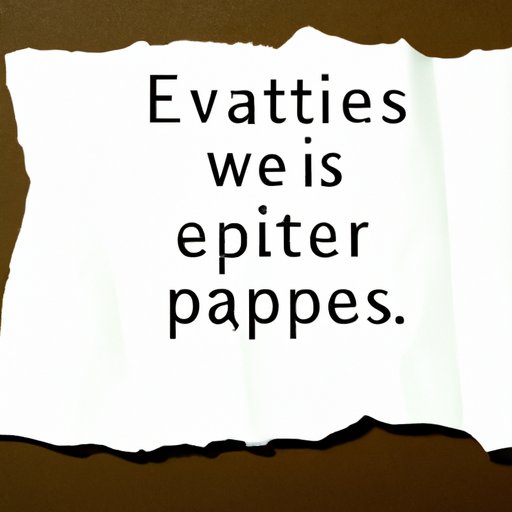
I. Introduction
Have you ever wondered what would happen if you ate paper? More importantly, if you or someone you know has a compulsion to eat paper, what are the potential health consequences and treatment options available? This article aims to investigate the physical effects, nutritional value, and potential dangers of consuming paper, as well as exploring the psychological condition known as pica, which makes some individuals crave non-food items such as paper.
II. The Consequences of Consuming Paper: an Investigation into the Physical Effects on the Body
While paper is not considered toxic or poisonous, it is not meant to be consumed. When ingested, paper can cause digestive problems such as stomach cramps, diarrhea, and constipation. It can also cause blockages in the digestive system, which may require medical attention. If the paper ingested is coated with chemicals or ink, there is a risk of toxicity and adverse reactions. Long-term abuse of paper ingestion can lead to malnutrition and weight loss.
III. Why Some People Have a Compulsion to Eat Paper and What It Really Means
People who have a compulsion to eat non-food items like paper or dirt have a condition called pica. Pica can be a symptom of an underlying mental or emotional issue. Pica can also be a sign of nutrient deficiencies in the body if the item craved is something that the body needs, such as iron or zinc. Pica can also occur in people with developmental or psychological disorders such as autism spectrum disorders or obsessive-compulsive disorder (OCD).
IV. The Nutritional Value (or Lack Thereof) in Consuming Paper
Paper is made of wood fibers, and it has no nutritional value. Consuming paper is similar to eating something indigestible like plastic or rocks. It fills the stomach, causing a sense of fullness briefly but does not meet any nutritional requirements or provide any energy for the body. Consuming too much paper may lead to unwanted weight loss, and in some cases, malnutrition.
V. The Potential Risks and Dangers of Ingesting Paper and How to Avoid Them
Ingesting paper is not safe, and it can pose health risks such as choking, intestinal blockage, and malnutrition. To avoid consuming paper by accident, make sure to store paper products out of reach from children and pets, and be mindful while eating near paper products. If you realize that you or someone you know has ingested paper, seek medical attention immediately, especially if symptoms persist.
VI. Real-life Stories: Individuals Who Have Eaten Paper and How It Impacted Their Health
There have been cases of people with pica who consumed paper, and it affected their health. A 2019 news article reported about a teenage girl who had been consuming four tissue boxes every week and was diagnosed with pica as a result. Her addiction to consuming paper products lead to digestive problems such as stomach pain and was ultimately linked to mineral deficiencies. The article also shared that other people with pica have undergone surgery to remove blockages in the digestive system caused by non-food items.
VII. Conclusion
In conclusion, consuming paper can have adverse health effects on the body, and it has no nutritional value. Eating paper can be a symptom of underlying health issues, and anyone with a compulsion to eat non-food items like paper should seek professional help. It is essential to avoid ingesting paper to prevent digestive problems, blockages, and malnutrition. Remember, if you or someone you know has ingested paper, seek medical attention immediately. Remember, help is available for those struggling with pica, and together, we can break the taboo and raise awareness to promote better health and well-being.





